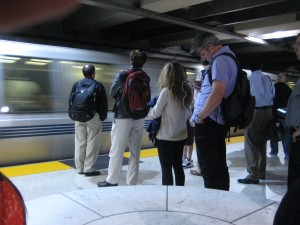Who thought of this idea first? Humans or Lobsters.

- Mobs of lobsters walking single file to deeper water for Winter. Notice how no one is running or trying to cut.
Last week I (as many of the other interns mirrored) spent the week reading and reading many reports about everything everyone is doing.
My supervisor had us outline all the main projects (3) we would be working on in a Work Plan. The project I want to finish first is helping with figuring out a method to do spacially/temporally regulations in Belize.
Translation: Cut the body of water into pie slices and tell people to rotate slices so certain stocks can regrow while other slices are utilized.
I’ve been doing a lot of research to back this idea up. So…..
SUBJECT: SPINY LOBSTERS IN THE GULF OF MEXICO
They are indeed spiny, but much sought after because they’re tasty.
A word I repeatedly read to describe this lobster is: Gregarious.
For a creature that spends most of it’s life building a den and dwelling in it (what I learned from the Monterey Bay Aquarium, but it may be species specific) I was open mind that maybe it could be both gregarious sometimes and sometimes a hermit…Just like people I suppose.
Love story: Female lobsters are smaller than males, and will spray chemicals to seduce the male lobster. This means female lobsters guest at the male lobster’s cozy home for a while. Don’t worry, the stuff wears away eventually. They’re not a monogamous creature (thank goodness at the rate humans eat them!). Females then walk away with the males sperm in a capsule for later (when she feels like the time is right for laying her eggs). She may have other priorities first. She knows best.
All the females and males aggregate when it’s time to move below 90 meters for Winter annually. They line up antennae to tail and follow the leader down down down.

- See! Antennae to tail!
- Why do you think they do that? Line up to migrate? Why wouldn’t the lobsters migrate to the secret meeting spot on their own? It’s not like they have a crowd of other sea animals in their way (like how some people need to hold hands to stay together in a crowd). We don’t know. No one knows (Yet).
STORY:
I take the bart home to and from work everyday. Yesterday, I happened to hit rush hour (something I managed to avoid the prior week). What I saw was so intriguing I took a picture (yes, I was the weirdo, but I’ve a blog!).

- Humans organized into lines (sometimes with over 20 people) taking the SF metro
In all my years of taking the bart, and trying many metro stations in other countries, this was a new phenomenon.
Lines! Patience! Some lines so long they were like spaghetti noodles wavering in the underground tunnel breeze.
For the same reason people can’t explain the spiny lobster’s behavior I can’t explain this picture of SF.
I’m proud to see humans evolving, to use patience and strategy (there were several lines parallel depending on the bart destination) instead of swarming into the bart to get home (that’s how I’ve experienced it in the past).
REFLECTION:
Hearing all the controversy on the news between governments trying to implement catch shares or marine protected areas to people who don’t want them, many NGOs trying to educate consumers to make better choices and instead confusing them, and observing and understanding the frustrations of fishermen who are losing their livelihoods, freedoms, and maybe not seeing quick results from still new methods (catch shares and Marine protected areas are new! and are culture sensitive, ecosystem sensitive, and have flaws that need to be tested out).
It’s all chaos! The more I learn, I worry that maybe all my effort in this field won’t make a difference. That, no matter how wonderful models are built to protect the ecosystem, to allow for best growth of fish to feed people, collaboratives built for stakeholders to communicate with each other on solutions….peoples’ greed and anxiety will overwhelm all and any plans to organize things.
However, there’s hope. Learning that these lobsters can transcend the frenzy, and that urban commuters can also transcend the frenzy.
This makes me feel better about this whole crazy field of Environmental Sustainability.




